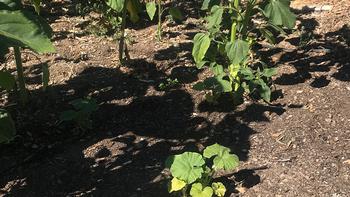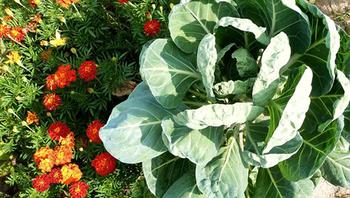News from the Edible Demo Garden
July 2022: Plant Partners

 Marigolds partner with cabbage to reduce damage by aphids. Photo: pixnio
Companion Planting
Marigolds partner with cabbage to reduce damage by aphids. Photo: pixnio
Companion Planting

Companion planting as a gardening technique has been practiced for generations, based on discoveries about how combining two or more plant species together can provide mutual advantages and enhance growth and production. The classic example is the Native American “three sisters” plantings combining corn, beans, and squash. Ideally, the corn provides structure to support the pole beans and the squash spreads out underneath the other plants. The best plant companions do more than just grow well side-by-side, they interact and form partnerships which benefit one or more of them.
How Plant Partnerships Work
Many old beliefs about which plants make good companions are based on folklore or trial and error rather than sound science. Fortunately, there are now numerous credible studies and controlled experiments that are helping to explain the ecosystems that enable edible garden plants to thrive. There are many ways in which one plant can influence another by either enhancing conditions for growth or increasing protection against threats.
- Enhancing conditions for growth
Certain plant partners can improve soil composition by breaking up heavy soil or assisting in nitrogen transfer. Companion plants can increase the number and diversity of pollinators leading to higher yields. A sturdy upright plant can serve as a living trellis to support a vine crop. Plant partners can also promote the health of beneficial soil-dwelling organisms and assist in the movement of nutrients within the soil.
- Increasing protection against threats
Probably the most common goal of companion planting is to manage pest insects. Studies have demonstrated that some plant partners are able to confuse pests and make it harder for them to find their preferred host plant on which to feed or lay eggs. The chemical and visual cues on which the insect pests rely are masked by the companion plant. Weed management without herbicides can be another plant partnership benefit. Some plants produce chemical compounds that inhibit weed growth and others act as living mulch. Finally, there is evidence that certain plant diseases can be suppressed through plant partnerships.
A Few Examples of Tested Plant Partners
- Peas and Lettuce – Both are cool-season crops with different growth structures. The peas climb while the lettuce stays low. The peas benefit the lettuce by shading them in warmer weather and providing nitrogen via the mycorrhizal network.
- Pak Choi or Radish and Eggplant, Peppers, and Tomatoes – Pak choi and radish are favorites of flea beetles. Planting radish or pak choi a few weeks ahead of the other vegetable crop can serve to trap the flea beetles and reduce damage to other vegetables.
- Tomatoes and Basil – This combination can work in the garden as well as in the kitchen. The basil serves to mask the tomato plants from thrips, small sucking insects that can damage tomato plants and fruit.
- Cosmos and Cabbage - Combining members of the aster family (which includes coreopsis, yarrow, zinnias, and marigolds) with cabbage, broccoli, cauliflower, kale, and other members of the cabbage family has been shown to reduce aphid numbers by attracting beneficial, aphid-eating insects.
Diversification is Key
Plant partnerships work because they support diversity in the garden and contribute to a healthy ecosystem. Not all plant partnerships work as planned in home gardens. There can be unwanted competition, the timing might be off, or the location might not be right. But even when there seems to be no measurable success, the hidden benefits of an environmentally friendly garden can be appreciated.
More information on growing edibles is available on this website at http://marinmg.ucanr.edu/EDIBLES/.
